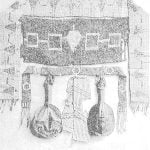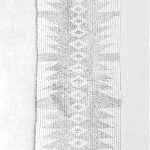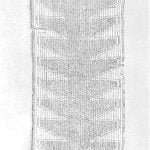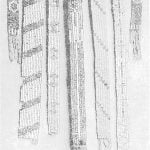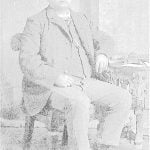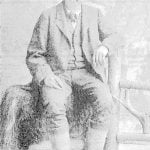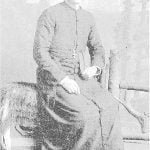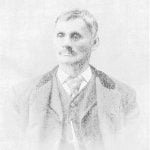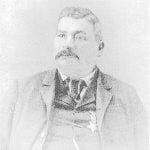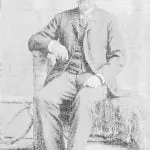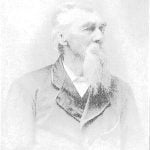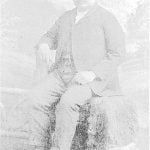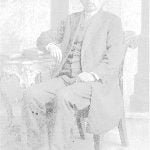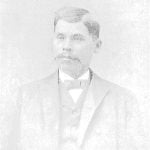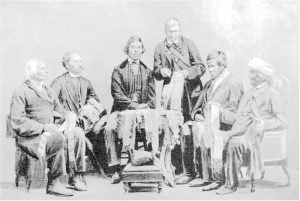
Named from left to right: Joseph Snow (Chan-ly-e-ya, Drifted Snow), Onondaga chief; George H. M. Johnson (Je-yung-heh-kwung, Double Life), Mohawk chief, official interpreter; John Buck (Skan-a-wa-ti, Beyond the Swamp), Onondaga chief, keeper of the wampum; John Smoke Johnson (Sack-a-yung-kwar-to. Disappearing Knot), Mohawk chief, speaker of the council, father of George H. M. Johnson; Isaac Hill (Te-yem-tho-hi-sa, Two Doors Closed), Onondaga chief; and John Seneca Johnson (Ka-nun g-he-ri-taws, Entangled Hair Given), Seneca chief.
The Iroquois League had its democratic and republican elements, but the separate national governments were essentially oligarchic. The only semblance of written law was the wampum. It was the duty of the “keeper of the wampums” to store all necessary facts in his memory and associate them with the successive lines and arrangements of the beads so that they could readily be called to mind. At general councils the wampums were produced and solemnly expounded.
“Reading the wampums” became therefore a means by which to perpetuate treaties, and the exchange of wampums was an impressive occasion. Both the Canadian and New York divisions of the Six Nations retain as national heirlooms these evidences of the chief facts in their national life.
The St. Regis Indians, living on both sides of the St. Lawrence river, have a small collection of wampums, fewer than the Onondagas at Onondaga castle, near Syracuse. The Onondagas retain the custody of the wampums of the Five Nations, and the “keeper of the wampums”, Thomas Webster, of the Snipe tribe, a consistent, thorough pagan, is their interpreter. The “reading of the wampums” to the representatives of the tribes gathered at St. Regis makes a suggestive picture.
According to the Narrative of Indian Wars in New England, the original wampum belts of the Iroquois, in which the laws of the league were recorded, “was made of spiral water shells, strung on deerskin strings or sinew and braided into belts or simply united into strings”. Mr. Hubbard describes the wampum as “of two sorts, white and purple”. The white is worked out of the inside of the great conch shell into the form of a bead, and perforated to string on leather. The purple is worked out of the inside of the mussel shell. A single wampum representing the Onondagas by a heart, in the center of the league, and older than the settlement by the white, people, or, as claimed, dating back to Champlain’s invasion in 1608, contains over 6,000 white and purple beads made of shell or bone. Another of later date, 6 feet in length and 15 strings wide, and containing 10,000 beads, represents the first treaty between the league and the United States. In the center is a building representing the new capitol. On each side is a figure representing Washington and the president of the league, while, hand in hand, the 13 colonies or states, on one side 7 and on the other side 6, in all 15 figures, complete the memorial record. The mat on which the president of the league (to-do-da-ho) is supposed to have sat when the league was instituted, about the middle of the sixteenth century, and the suspended mat to “keep off the dust” are still in good preservation. One wampum represents the conclusion of peace with 7 Canadian tribes who had been visited by the Jesuits, having a cross for each tribe, and with a zigzag line below, to indicate that their ways had been crooked but would ever after be as sacred as the cross. Still another memorial of days of craft and treachery while the league was too feeble to take the field against the Algonquin tribes represents a guarded gate, with a long, white path leading to the inner gate, where the Five Nations are grouped, with the Onondagas in the center and a safe council house behind all. There are 11 of these historic wampums, each fraught with traditional story of persons and events.
Daniel La Forte, who has been chairman or president of the league, and also of the Onondagas, and elsewhere referred to, still insists that the wampums, as expounded by Thomas Webster, are “government enough for the nation, and lay down all the rules of duty that are needed “.
The fact that the people can have no key to their own “laws”, and that the dictum of the wampum reader is binding, just as his memory or interpretation of the emblem shall dictate, seems to weigh little with the Pagan party. Notwithstanding the claims made that the wampums can be read as a governing code of law, it is evident that they are simply monumental reminders of preserved traditions, without any literal details whatever. As curious relics they are valuable.
Photographs of all the wampums were obtained to accompany the report of the Six Nations Indians, with the explanation of each as read by the “wampum keeper”. The mat of the to-do-da-ho and the wing (mat) used by the headman to shield him from the dust while presiding at the council are well preserved. The first group, from left to right, represents a convention of the Six Nations, at the adoption of the Tuscaroras into the league; the second, the Five Nations, upon 7 strands, illustrates a treaty with 7 Canadian tribes before the year 1600; the third signifies the guarded approach of strangers to the councils of the Five Nations; the fourth represents a treaty when but 4 of the Six Nations were represented, and the fifth embodies the pledge of 7 Canadian “Christianized” nations to abandon their crooked ways and keep an honest peace. . Above this group is another, claiming to bear date about 1608, when Champlain joined the Algonquins’ against the Iroquois. The second group includes, also in the center, the official memorial of the organization of the Iroquois confederacy, relating back to about the middle of the sixteenth century, and immediately over that of 1608, suspended between the “turtle rattles”, which were used at the feather dance at Cattaraugus January 21, 1891, is a ragged wampum of unknown antiquity. Above, and containing the general group, is the wampum memorial of the first treaty made by Washington on behalf of the 13 original states and the president of the Six Nations at the national capital.

